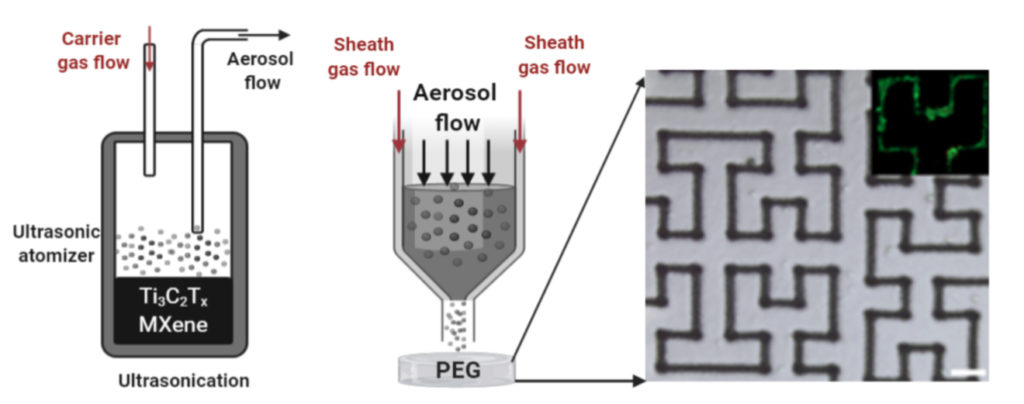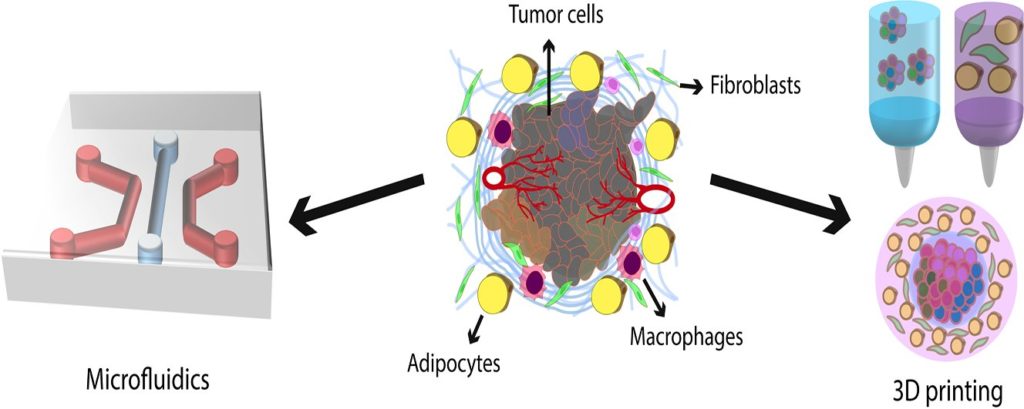Electrically conductive 3D printed Ti3C2Tx MXene-PEG composite constructs for cardiac tissue engineering

As cardiovascular diseases and specifically myocardial infarction (MI) continue to be the leading cause of death worldwide, it is critical that new clinical interventions be developed. Tissue engineered cardiac patches have shown significant potential as clinical therapeutics to promote recovery following MI. Unfortunately, current constructs lack the ordered structure and electroconductivity of native human heart. In this study, we engineered a composite construct that can provide both conductive and topographical cues for human induced pluripotent stem cell derived cardiomyocytes. By 3D printing conductive Ti3C2Tx MXene in pre-designed patterns on polyethylene glycol hydrogels, using aerosol jet printing, at a cell-level resolution, we developed tissue engineered patches that have the potential for providing a new clinical therapeutic to combat cardiovascular disease.
Breast cancer models: Engineering the tumor microenvironment
The mechanisms behind cancer initiation and progression are not clear. Therefore, development of clinically relevant models to study cancer biology and drug response in tumors is essential. In vivo models
are very valuable tools for studying cancer biology and for testing drugs; however, they often suffer from
not accurately representing the clinical scenario because they lack either human cells or a functional immune system. On the other hand, two-dimensional (2D) in vitro models lack the three-dimensional (3D)
network of cells and extracellular matrix (ECM) and thus do not represent the tumor microenvironment
(TME). As an alternative approach, 3D models have started to gain more attention, as such models offer
a platform with the ability to study cell-cell and cell-material interactions parametrically, and possibly
include all the components present in the TME. Here, we first give an overview of the breast cancer TME,
and then discuss the current state of the pre-clinical breast cancer models, with a focus on the engineered 3D tissue models. We also highlight two engineering approaches that we think are promising in
constructing models representative of human tumors: 3D printing and microfluidics. In addition to giving basic information about the TME in the breast tissue, this review article presents the state-of-the-art
tissue engineered breast cancer models.
Dual crosslinked gelatin methacryloyl hydrogels for photolithography and 3D printing
Gelatin methacryloyl (GelMA) hydrogels have been used in tissue engineering and regenerative medicine because of their biocompatibility, photopatternability, printability, and tunable mechanical and rheological properties. However, low mechanical strength limits their applications in controlled drug release, non-viral gene therapy, and tissue and disease modeling. In this work, a dual crosslinking method for GelMA is introduced. First, photolithography was used to pattern the gels through the crosslinking of methacrylate incorporated amine groups of GelMA. Second, a microbial transglutaminase (mTGase) solution was introduced in order to enzymatically crosslink the photopatterned gels by initiating a chemical reaction between the glutamine and lysine groups of the GelMA hydrogel. The results showed that dual crosslinking improved the stiffness and rheological properties of the hydrogels without affecting cell viability, when compared to single crosslinking with either ultraviolet (UV) exposure or mTGase treatment. Our results also demonstrate that when treated with mTGase, hydrogels show decreased swelling properties and better preservation of photolithographically patterned shapes. Similar effects were observed when three dimensional (3D) printed and photocrosslinked substrates were treated with mTGase. Such dual crosslinking methods can be used to improve the mechanical properties and pattern fidelity of GelMA gels, as well as dynamic control of the stiffness of tissue engineered constructs.

Recent Comments